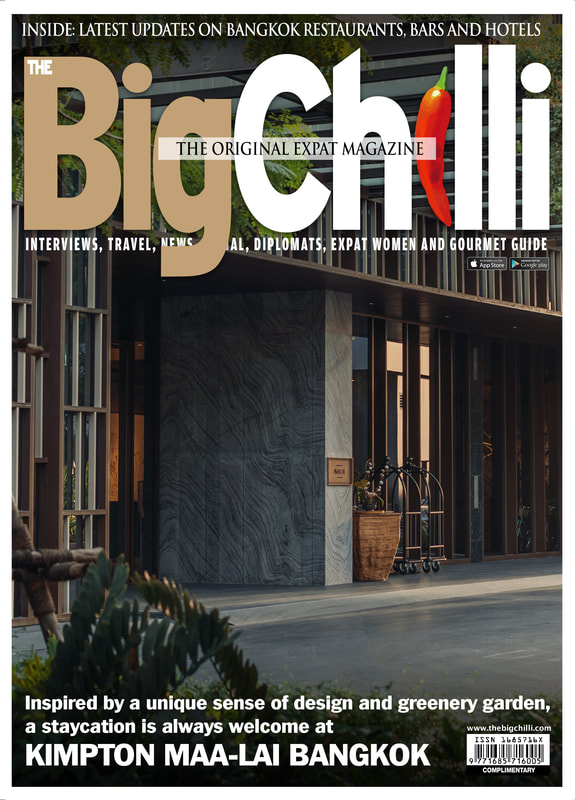Why everybody should hail Bangkok’s cabbies
Most people would agree it’s a lousy job but someone’s got to do it. Without taxis, the city simply wouldn’t function. So that’s why it’s only right to applaud this hardy and often unfairly maligned group of workers.
Maxmilian Wechsler talks to four cabbies about their day-to-day challenges on Bangkok’s congested streets
Most people would agree it’s a lousy job but someone’s got to do it. Without taxis, the city simply wouldn’t function. So that’s why it’s only right to applaud this hardy and often unfairly maligned group of workers.
Maxmilian Wechsler talks to four cabbies about their day-to-day challenges on Bangkok’s congested streets
| BANGKOK’S uniquely colored taxis are so much a part of the local scenery that it’s hard to imagine the capital without them. You see them everywhere, day and night, in numbers not matched anywhere else. More than 100,000 taxis are registered with the Department of Land and Transport (DLT), either privately owned or rented from over 100 taxi companies and cooperatives in the city. Driving a cab is a stressful and sometimes dangerous occupation. To make a living and support their families, these hardy individuals spend long hours driving on chronically congested and often dilapidated roads, enveloped by noxious fumes and forever facing the possibility of picking up some unsavory characters. Taxi drivers are generally looked down upon by other motorists and often subjected to criticism from the media – sometimes warranted, sometimes not. |
Rare incidents like the one involving a taxi driver who attacked and killed an American man last July after a dispute over a 50-baht fare are widely publicized by local and foreign media. There are also numerous complaints over less serious incidents which put taxi drivers in a bad light.
For example, a letter printed recently in the Bangkok Post described how two foreigners hired a taxi to take them from Suvanabhumi Airport to the Silom area and were amazed to see the meter reading 2,077 baht for a distance of 255 kilometers when they arrived at their destination. They refused to pay, and walked away unmolested after giving the driver 300 baht.
According to the DLT, the most common complaints from Thai and foreign passengers concern drivers who refuse to accept a customer, impolite behavior, unusually high fares and failure to take a customer to an agreed destination. But the DLT says that it is only a relatively few of the city’s 100,000 cab drivers who tarnish the reputation of the overwhelming majority who don’t cheat customers, always use the meter and always deliver customers safely to their destination. Most frequent users of taxis in the city, whether Thai or foreign, would probably agree.
Unless they speak some Thai and want to talk to their taxi driver, most foreigners in Bangkok only know them by the backs of their heads.
In order to get an understanding of the typical taxi driver in the city, The BigChilli recently interviewed a number of drivers at length. To summarize, most said that it is getting increasingly difficult to make a living due to competition from other types of public transport like motorcycle taxis, minibuses and the BTS Skytrain and underground rail systems.
They also face competition from an ever increasing number of fellow taxi drivers. Most believe their future is bleak, especially as the vehicles they rent or buy are ageing rapidly and replacing them is almost impossibly expensive. To make ends meet, some cabbies take a second job, some gamble and a few look for ways to cheat customers.
For example, a letter printed recently in the Bangkok Post described how two foreigners hired a taxi to take them from Suvanabhumi Airport to the Silom area and were amazed to see the meter reading 2,077 baht for a distance of 255 kilometers when they arrived at their destination. They refused to pay, and walked away unmolested after giving the driver 300 baht.
According to the DLT, the most common complaints from Thai and foreign passengers concern drivers who refuse to accept a customer, impolite behavior, unusually high fares and failure to take a customer to an agreed destination. But the DLT says that it is only a relatively few of the city’s 100,000 cab drivers who tarnish the reputation of the overwhelming majority who don’t cheat customers, always use the meter and always deliver customers safely to their destination. Most frequent users of taxis in the city, whether Thai or foreign, would probably agree.
Unless they speak some Thai and want to talk to their taxi driver, most foreigners in Bangkok only know them by the backs of their heads.
In order to get an understanding of the typical taxi driver in the city, The BigChilli recently interviewed a number of drivers at length. To summarize, most said that it is getting increasingly difficult to make a living due to competition from other types of public transport like motorcycle taxis, minibuses and the BTS Skytrain and underground rail systems.
They also face competition from an ever increasing number of fellow taxi drivers. Most believe their future is bleak, especially as the vehicles they rent or buy are ageing rapidly and replacing them is almost impossibly expensive. To make ends meet, some cabbies take a second job, some gamble and a few look for ways to cheat customers.
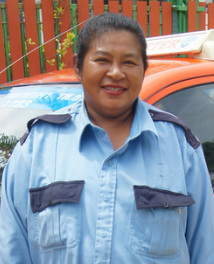
Mrs Srisaang Ruangthai:
“I don’t carry any weapons, but I’ve developed an instinct and if I feel there could be trouble from a passenger I won’t go.”
Srisaang Ruangthai is one of Bangkok’s small band of lady taxi drivers. Born in Nonthaburi province, she is married with one child. Srisaang has driven her own cab for four years. Before that she was a housewife, but decided to start driving because she wanted to help her husband provide for the family. She says she likes the freedom of driving her own taxi and not having a boss.
“I am driving a Toyota Limo I bought on hire-purchase in 2006 for 700,000 baht, and I joined with a large taxi cooperative. They painted the car and installed the radio transceiver. They can contact me and find customers for me. I can also call for help in case of trouble or an accident. The car has GPS installed, so the company always knows where I am. I pay them a fee of 2,000 baht per year,” Mrs Srisaang said.
“I usually drive from 6am to 11pm. I take the passenger anywhere he or she wants to go, whatever the distance. My daily expense is about 700 baht, most of it for LPG fuel. I drive a lot and clear up to 1,000 baht a day.
“There are now more taxis in Bangkok than when I started, but I think that there are also more people looking for taxis than before as the population is increasing.
“I will accept all passengers except those who look ‘rough’, are drunk or look like they’re on drugs. I am more careful if the customer wants to go to a small soi or isolated place. If I don’t know the destination or the customer is not sure where to go, I won’t drive. I don’t carry any weapon or any kind of protection, but I’ve developed an instinct and if I feel there could be trouble I won’t go.
“However, sometimes I will take a risk and accept a customer I don’t like the looks of or go to a place I don’t really want to go. This makes me afraid, but so far I’ve never been attacked or experienced any problems with a passenger.
“So far, I’ve only had three customers who haven’t paid the fare - they were all teenagers. Two just took off from the taxi after arriving at the destination. I didn’t chase them. The third said that he didn’t have any money, so I just let him go.”
Mrs Srisaang said she has third class insurance.
She said she didn’t get much training before taking to the road but knows Bangkok and surrounding provinces pretty well. She goes to the DLT twice a year for a road worthiness check of her cab, which is required for all taxis. Mrs Srisaang said she receives a tip from almost all her passengers and checks the taxi before they leave to see if they have left any belongings. She will allow small animals provided they are properly secured by the owner.
“I will accept any person wherever they are going, even if it’s Pantip Plaza and there’s a traffic jam on Petchaburi Road, because this is my job. I can’t choose.”
She believes taxi fares should be raised. “Everything is going up, so why should taxi fares be excluded?
“There are too many taxis in Bangkok. I will drive this car for two or three more years, until it is too old and in bad condition. Then I will buy a new one or retire,” Mrs Srisaang said.
“I don’t carry any weapons, but I’ve developed an instinct and if I feel there could be trouble from a passenger I won’t go.”
Srisaang Ruangthai is one of Bangkok’s small band of lady taxi drivers. Born in Nonthaburi province, she is married with one child. Srisaang has driven her own cab for four years. Before that she was a housewife, but decided to start driving because she wanted to help her husband provide for the family. She says she likes the freedom of driving her own taxi and not having a boss.
“I am driving a Toyota Limo I bought on hire-purchase in 2006 for 700,000 baht, and I joined with a large taxi cooperative. They painted the car and installed the radio transceiver. They can contact me and find customers for me. I can also call for help in case of trouble or an accident. The car has GPS installed, so the company always knows where I am. I pay them a fee of 2,000 baht per year,” Mrs Srisaang said.
“I usually drive from 6am to 11pm. I take the passenger anywhere he or she wants to go, whatever the distance. My daily expense is about 700 baht, most of it for LPG fuel. I drive a lot and clear up to 1,000 baht a day.
“There are now more taxis in Bangkok than when I started, but I think that there are also more people looking for taxis than before as the population is increasing.
“I will accept all passengers except those who look ‘rough’, are drunk or look like they’re on drugs. I am more careful if the customer wants to go to a small soi or isolated place. If I don’t know the destination or the customer is not sure where to go, I won’t drive. I don’t carry any weapon or any kind of protection, but I’ve developed an instinct and if I feel there could be trouble I won’t go.
“However, sometimes I will take a risk and accept a customer I don’t like the looks of or go to a place I don’t really want to go. This makes me afraid, but so far I’ve never been attacked or experienced any problems with a passenger.
“So far, I’ve only had three customers who haven’t paid the fare - they were all teenagers. Two just took off from the taxi after arriving at the destination. I didn’t chase them. The third said that he didn’t have any money, so I just let him go.”
Mrs Srisaang said she has third class insurance.
She said she didn’t get much training before taking to the road but knows Bangkok and surrounding provinces pretty well. She goes to the DLT twice a year for a road worthiness check of her cab, which is required for all taxis. Mrs Srisaang said she receives a tip from almost all her passengers and checks the taxi before they leave to see if they have left any belongings. She will allow small animals provided they are properly secured by the owner.
“I will accept any person wherever they are going, even if it’s Pantip Plaza and there’s a traffic jam on Petchaburi Road, because this is my job. I can’t choose.”
She believes taxi fares should be raised. “Everything is going up, so why should taxi fares be excluded?
“There are too many taxis in Bangkok. I will drive this car for two or three more years, until it is too old and in bad condition. Then I will buy a new one or retire,” Mrs Srisaang said.
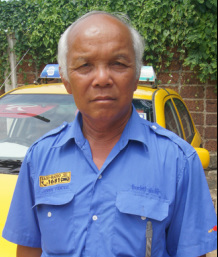
Jansri Pandee:
“Buying my own taxi was the right decision”
Mr Jansri Pandee owns his taxi and has been driving since 1987. He was born in the Rangsit area of Bangkok and is married with three children.
“Before becoming a taxi driver I worked at the Chulalongkorn hospital pharmacy. After leaving that job I decided to buy a taxi and drive it myself, and looking back, I made the right decision. I don’t have to pay rent to the taxi company or worry whether they have a car available for me, and I can drive when I want, which is the best part. I like to be free and independent,” Mr Jansri said.
“I drive a Toyota Limo which I bought for 950,000 baht on a hire-purchase arrangement, including interest for five years. It is the third car I have owned since becoming a taxi driver,” said Mr Jansri, adding that there are many places in Bangkok where a taxi can be bought.
Mr Jansri normally works from 6am to 4pm. He doesn’t work at night because the glare from oncoming headlights bothers his eyes. He knows Bangkok and surrounding provinces very well and there are not too many places he hasn’t been. If a customer wants to go up-country, he will usually use the meter but charges an extra 300 baht to cover fuel costs for the return trip to Bangkok. He can speak some English and doesn’t have a radio transceiver installed in his car because, as he says, “I don’t need one.
“My car runs on natural gas (NGV) and the fuel cost is about 400 baht a day. I can usually take in about 1,500 baht per day, so my profit is around 1,100 baht. But it’s getting harder. When I started to drive, there were only buses, tuk-tuks and boats to compete with. Now it is motorcycle taxis, minibuses and mass transit,” said Mr Jansri, adding that motorcycle taxis take the biggest chunk of customers from taxis.
He said he normally accepts any customer, though on occasions he might refuse a fare during early morning or evening rush hours because he can’t afford to waste fuel by standing in traffic.
Driving a taxi is not particularly dangerous, but he is careful because customers have tried to rob him in the past. He doesn’t like to accept customers who have been drinking heavily, but usually will if they don’t appear too drunk. “I tell them not to make the car dirty (he’s especially worried about them vomiting, as has happened on a few occasions), and they must tell me their exact destination.
“It’s only happened a few times that passengers couldn’t pay the fare; these are usually drunken Thais, men or women, who just don’t have the money. Once a passenger couldn’t pay a 900 baht fare, which is the highest amount I have ever lost. I don’t fight with them, I just let them go.”
Mr Jansri said he always asks customers if they want to use the expressway because the trip will cost more. As for some well known scams, he said: “I don’t look for foreigners to take them to massage to jewelry shops or shows. Some taxi drivers do this for a commission.
“I prefer to drive around Bangkok and I don’t like to wait for customers outside hotels, shopping centers or housing developments.”
He’s never had a problem with foreigners, and even says they are “very generous” and almost always give a tip.
“One foreigner with a Thai girlfriend offered me 1,800 baht for a trip to Koh Samet instead of the 2,000 baht I asked for, but I accepted the offer. After arriving at the destination, the guy gave me 2,000 baht because he enjoyed the trip,” Mr Jansri said.
When asked his thoughts on the killing of the American, he replied: “I don’t know the facts, or who started the trouble, so I can’t comment. I only know what the media said. Surely, it is an unfortunate incident which shouldn’t have happened.”
Mr Jansri said if a passenger forgets something inside his taxi, which doesn’t happen too often, he will drive back to the point where he dropped the customer and wait there for a while.
“I don’t like children in my cab because they often behave badly. I will accept small animals like cats or dogs provided they are inside a cage or bag. I will accept four or even five passengers if they aren’t too big and heavy. Sometimes two persons take all the space in the back.”
Mr Jansri said the police sometimes stop and fine taxi drivers for small things such as wearing sandals instead of proper shoes, or if their name is not prominently displayed in Thai and English.
He believes fares should stay at their current rate because if they are increased passengers might opt for other modes of transportation.
“Buying my own taxi was the right decision”
Mr Jansri Pandee owns his taxi and has been driving since 1987. He was born in the Rangsit area of Bangkok and is married with three children.
“Before becoming a taxi driver I worked at the Chulalongkorn hospital pharmacy. After leaving that job I decided to buy a taxi and drive it myself, and looking back, I made the right decision. I don’t have to pay rent to the taxi company or worry whether they have a car available for me, and I can drive when I want, which is the best part. I like to be free and independent,” Mr Jansri said.
“I drive a Toyota Limo which I bought for 950,000 baht on a hire-purchase arrangement, including interest for five years. It is the third car I have owned since becoming a taxi driver,” said Mr Jansri, adding that there are many places in Bangkok where a taxi can be bought.
Mr Jansri normally works from 6am to 4pm. He doesn’t work at night because the glare from oncoming headlights bothers his eyes. He knows Bangkok and surrounding provinces very well and there are not too many places he hasn’t been. If a customer wants to go up-country, he will usually use the meter but charges an extra 300 baht to cover fuel costs for the return trip to Bangkok. He can speak some English and doesn’t have a radio transceiver installed in his car because, as he says, “I don’t need one.
“My car runs on natural gas (NGV) and the fuel cost is about 400 baht a day. I can usually take in about 1,500 baht per day, so my profit is around 1,100 baht. But it’s getting harder. When I started to drive, there were only buses, tuk-tuks and boats to compete with. Now it is motorcycle taxis, minibuses and mass transit,” said Mr Jansri, adding that motorcycle taxis take the biggest chunk of customers from taxis.
He said he normally accepts any customer, though on occasions he might refuse a fare during early morning or evening rush hours because he can’t afford to waste fuel by standing in traffic.
Driving a taxi is not particularly dangerous, but he is careful because customers have tried to rob him in the past. He doesn’t like to accept customers who have been drinking heavily, but usually will if they don’t appear too drunk. “I tell them not to make the car dirty (he’s especially worried about them vomiting, as has happened on a few occasions), and they must tell me their exact destination.
“It’s only happened a few times that passengers couldn’t pay the fare; these are usually drunken Thais, men or women, who just don’t have the money. Once a passenger couldn’t pay a 900 baht fare, which is the highest amount I have ever lost. I don’t fight with them, I just let them go.”
Mr Jansri said he always asks customers if they want to use the expressway because the trip will cost more. As for some well known scams, he said: “I don’t look for foreigners to take them to massage to jewelry shops or shows. Some taxi drivers do this for a commission.
“I prefer to drive around Bangkok and I don’t like to wait for customers outside hotels, shopping centers or housing developments.”
He’s never had a problem with foreigners, and even says they are “very generous” and almost always give a tip.
“One foreigner with a Thai girlfriend offered me 1,800 baht for a trip to Koh Samet instead of the 2,000 baht I asked for, but I accepted the offer. After arriving at the destination, the guy gave me 2,000 baht because he enjoyed the trip,” Mr Jansri said.
When asked his thoughts on the killing of the American, he replied: “I don’t know the facts, or who started the trouble, so I can’t comment. I only know what the media said. Surely, it is an unfortunate incident which shouldn’t have happened.”
Mr Jansri said if a passenger forgets something inside his taxi, which doesn’t happen too often, he will drive back to the point where he dropped the customer and wait there for a while.
“I don’t like children in my cab because they often behave badly. I will accept small animals like cats or dogs provided they are inside a cage or bag. I will accept four or even five passengers if they aren’t too big and heavy. Sometimes two persons take all the space in the back.”
Mr Jansri said the police sometimes stop and fine taxi drivers for small things such as wearing sandals instead of proper shoes, or if their name is not prominently displayed in Thai and English.
He believes fares should stay at their current rate because if they are increased passengers might opt for other modes of transportation.
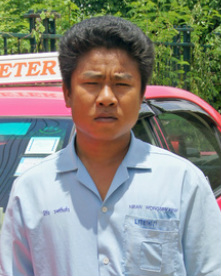
Niran Wongsrikaew:
“The worst customers are children”
Mr Niran Wongsrikaew comes from the northeastern province of Roi-Et. He is married with one child. After working in Taiwan for four years, he decided on his return about a year ago to drive a taxi. Many Bangkok taxi drivers seem to come from Roi-Et, which suggests an employment problem in this particular province.
“I rent a Toyota Limo from a taxi company that trained me for the job. I rent the car for 450 baht a shift and spend about 300 baht for NGV. I drive daily from 4am to 4pm. My net income is about 400 baht per day. I would prefer to own my own taxi so I wouldn’t have to pay rent everyday but at this time I don’t have enough money to even to make the required deposit. I can get a taxi every day, there’s always one available for me. I don’t drive non-stop but prefer to wait outside housing developments or condos. There are plenty around now,” Mr Niran said.
“I will bring customers anywhere, whether a short or long distance. This is my job. I will only refuse people if they are drunk, have many tattoos, are dirty or they look dangerous. I am afraid of these customers. But the worst are children. They often play around inside the car and make me nervous so I can’t concentrate.
“I usually get tips from Thais and foreigners. I will accept five customers provided they are not fat. Before the customer leaves my taxi, I will check to see if they have forgotten something inside the car.”
Mr Niran said he hasn’t had many bad experiences with passengers, but still remembers the time one cheated him out of almost 1,000 baht: “I took a passenger, a lady, from Pathum Thani to Lakrabang. After we arrived at the destination she just ran away. I didn’t chase her.”
Mr Niran, who cannot speak any English, said he believes taxi fares should be increased, but not too much.
“The worst customers are children”
Mr Niran Wongsrikaew comes from the northeastern province of Roi-Et. He is married with one child. After working in Taiwan for four years, he decided on his return about a year ago to drive a taxi. Many Bangkok taxi drivers seem to come from Roi-Et, which suggests an employment problem in this particular province.
“I rent a Toyota Limo from a taxi company that trained me for the job. I rent the car for 450 baht a shift and spend about 300 baht for NGV. I drive daily from 4am to 4pm. My net income is about 400 baht per day. I would prefer to own my own taxi so I wouldn’t have to pay rent everyday but at this time I don’t have enough money to even to make the required deposit. I can get a taxi every day, there’s always one available for me. I don’t drive non-stop but prefer to wait outside housing developments or condos. There are plenty around now,” Mr Niran said.
“I will bring customers anywhere, whether a short or long distance. This is my job. I will only refuse people if they are drunk, have many tattoos, are dirty or they look dangerous. I am afraid of these customers. But the worst are children. They often play around inside the car and make me nervous so I can’t concentrate.
“I usually get tips from Thais and foreigners. I will accept five customers provided they are not fat. Before the customer leaves my taxi, I will check to see if they have forgotten something inside the car.”
Mr Niran said he hasn’t had many bad experiences with passengers, but still remembers the time one cheated him out of almost 1,000 baht: “I took a passenger, a lady, from Pathum Thani to Lakrabang. After we arrived at the destination she just ran away. I didn’t chase her.”
Mr Niran, who cannot speak any English, said he believes taxi fares should be increased, but not too much.
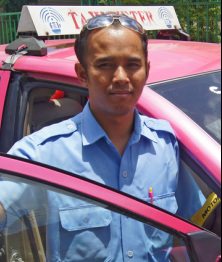
Tayplid Srikongruk:
Taxi drivers are robbed every day, especially going up-country.”
Tayplid Srikongruk was born in Chantanaburi and has been driving a taxi for only for four months. He is married with one child. Before becoming a cabbie he was a driver for a company in Bangkok and the job required him to go up-country frequently.
Mr Tayplid rents a Toyota Corolla for 700 baht a day (two shifts) from a leading taxi company and works long hours, sometimes 24 hours straight. “I use liquid petroleum gas (LPG) for fuel, which costs me about 600 baht for two shifts. After expenses I usually net around 500 or 600 baht.”
Mr Tayplid said he has no problems with the company he rents his taxi from and they provided him with training. Still, he would prefer to own his own vehicle because it is “more convenient and less worries.”
He said he will take passengers anywhere, any distance, whether in Bangkok or up-country, provided he knows the way. He either uses the meter or makes a prior agreement for payment with the customer.
“I will take all customers, but taxi drivers must be careful, especially in the evening. You can read almost daily in Thai newspapers about taxi drivers being robbed by passengers. Taxi drivers are robbed every day, especially going up-country. I think it is more dangerous for women drivers than men, and there are a lot of them these days. A few months ago a woman taxi driver took three Thai men to Nakhon Pathom province and they killed her there,” said Mr Tayplid.
He wouldn’t comment on the killing of the American, except to say “it is a tragedy.”
“I think that there are too many taxis in Bangkok already and the number is increasing. Many people now use motorcycle taxis, especially in early morning when it is not so hot. But after 9am or 10am, when it is getting warmer, they will switch to taxis.”
Like nearly all drivers, he has compulsory motor insurance (Por Ror Bor) and the company he rents the car from pays third class insurance.
“My car is equipped with a radio, so the company can contact me when a customer calls them and I can ask for directions or help when necessary. I will accept people carrying animals. Most of them want me to bring them to or from an animal clinic or hospital,” said Mr Tayplid.
He said he likes the job and the company he works for, and believes the 35 baht initial fare should remain the same.
Taxi drivers are robbed every day, especially going up-country.”
Tayplid Srikongruk was born in Chantanaburi and has been driving a taxi for only for four months. He is married with one child. Before becoming a cabbie he was a driver for a company in Bangkok and the job required him to go up-country frequently.
Mr Tayplid rents a Toyota Corolla for 700 baht a day (two shifts) from a leading taxi company and works long hours, sometimes 24 hours straight. “I use liquid petroleum gas (LPG) for fuel, which costs me about 600 baht for two shifts. After expenses I usually net around 500 or 600 baht.”
Mr Tayplid said he has no problems with the company he rents his taxi from and they provided him with training. Still, he would prefer to own his own vehicle because it is “more convenient and less worries.”
He said he will take passengers anywhere, any distance, whether in Bangkok or up-country, provided he knows the way. He either uses the meter or makes a prior agreement for payment with the customer.
“I will take all customers, but taxi drivers must be careful, especially in the evening. You can read almost daily in Thai newspapers about taxi drivers being robbed by passengers. Taxi drivers are robbed every day, especially going up-country. I think it is more dangerous for women drivers than men, and there are a lot of them these days. A few months ago a woman taxi driver took three Thai men to Nakhon Pathom province and they killed her there,” said Mr Tayplid.
He wouldn’t comment on the killing of the American, except to say “it is a tragedy.”
“I think that there are too many taxis in Bangkok already and the number is increasing. Many people now use motorcycle taxis, especially in early morning when it is not so hot. But after 9am or 10am, when it is getting warmer, they will switch to taxis.”
Like nearly all drivers, he has compulsory motor insurance (Por Ror Bor) and the company he rents the car from pays third class insurance.
“My car is equipped with a radio, so the company can contact me when a customer calls them and I can ask for directions or help when necessary. I will accept people carrying animals. Most of them want me to bring them to or from an animal clinic or hospital,” said Mr Tayplid.
He said he likes the job and the company he works for, and believes the 35 baht initial fare should remain the same.
| More cabbies’ comments MOST taxi drivers would prefer to own their own vehicles if possible because it allows them to be more independent. It also appears that private taxi drivers are more relaxed and friendly with passengers. Many drivers listen to Jor Sor FM 100 radio station, and call the station when a customer forgets valuables in the taxi. The station broadcasts traffic and other news and has helped many people to recover their possessions. Taxi drivers are always suspicious if one person hails a taxi and suddenly three of four people appear and jump in the taxi. One cabbie said that a well-dressed Thai man said he couldn’t pay after arriving at an isolated place and then asked to use his mobile phone so he could call a friend. The man then fled with the phone. Some taxi drivers have no driver’s license and for that reason they are afraid to drive to suburbs where police checkpoints are often set up because they might be fined. Others refuse to go to suburbs because they will likely have to come back “empty.” |
Some taxi drivers with large cars prefer to work at the airport or wait outside hotels or housing developments. After they take a customer to their destination they will return to the same places.
Taxi drivers waiting for customers outside Bangkok hotels are less likely to wear uniforms, as was the case with three drivers wearing jeans and T-shirts waiting outside a big hotel in Sukhumvit Soi 20. All spoke good English but didn’t want to give their names or be photographed. One refused to talk to us, while another said he would answer questions if we gave him 500 baht. The third talked freely for a while, saying all three drivers had been working at the same hotel for several years and they paid someone to let them park on the street all day and night outside the hotel, which is illegal.
He said he prefers to wait outside the hotel because he can choose his customers. He rents his car from a taxi company for 700 baht for two shifts. He doesn’t use the meter, but rather makes an agreement with customers on the fare.
“When the customer gets inside the car, I will try to take them to various tourist attractions and shopping spots because I get a commission. Most of my customers are families. Business is good and I can make good money in a few hours, instead of driving all day on the road,” the driver said, and then refused to say more.
By now the scams involving cabbies and tuk-tuks in tourist areas are well known. They get a hefty commission for bringing foreigners, or more precisely victims, to jewelry shops, tailors, massage parlors and other enterprises which are set up to bilk them.
It is worth noting that honest drivers rarely speak English well, which makes communication with foreigners difficult, while crooked cabbies generally do speak English fairly well. Of course, many honest drivers are also reasonably fluent in English, especially if they have been driving a long time.
Despite many drivers insisting they are willing to go anywhere, anytime, there’s no doubt that it’s increasingly common for drivers to refuse customers. Thais and foreigners alike sometimes feel they are at the mercy of taxi drivers, especially at certain times and places. One of the most notorious places for difficult cabbies is on Petchaburi Road outside of Pantip Plaza, where taxi drivers choose customers at their leisure. One foreigner with a sense of humor desperate to get out of the area asked a cabbie,
“Where do you want to go?”
Even in uncongested areas cabbies will sometimes ignore customers when they have to return the car to the company at the end of the shift. This mostly occurs at 2pm, 4pm or 6pm.
Speaking as someone who has ridden in hundreds if not thousands of Bangkok cabs over the years, I can honestly say that I have never had a really bad experience with a driver. But that doesn’t mean caution isn’t advisable, especially for females. By coincidence a young Dutch woman who is Bangkok on an internship for a few months recently had a unpleasant encounter with a taxi driver. She was accompanied by her Dutch friend, also female.
“We hired a taxi on Petchaburi Road to go to Klong Toey. We were both sitting in the rear,” explained the intern. “The driver could speak some English and started a conversation with us, asking the usual questions, like ‘what is your name’ and ‘where do you come from’. Shortly before we arrived at our destination, he said to me: ‘Let’s go to a cheap hotel.’ Before we got out in a hurry, he even tried to hug me,” the intern said.
“I am glad that my friend was with me because I don’t know what would happen if I was alone. I have never heard of such behavior by a taxi driver. He should lose his permit.” The intern said she wanted to lodge a complaint with the authorities but they were unable to record his name or car registration number
Taxi drivers waiting for customers outside Bangkok hotels are less likely to wear uniforms, as was the case with three drivers wearing jeans and T-shirts waiting outside a big hotel in Sukhumvit Soi 20. All spoke good English but didn’t want to give their names or be photographed. One refused to talk to us, while another said he would answer questions if we gave him 500 baht. The third talked freely for a while, saying all three drivers had been working at the same hotel for several years and they paid someone to let them park on the street all day and night outside the hotel, which is illegal.
He said he prefers to wait outside the hotel because he can choose his customers. He rents his car from a taxi company for 700 baht for two shifts. He doesn’t use the meter, but rather makes an agreement with customers on the fare.
“When the customer gets inside the car, I will try to take them to various tourist attractions and shopping spots because I get a commission. Most of my customers are families. Business is good and I can make good money in a few hours, instead of driving all day on the road,” the driver said, and then refused to say more.
By now the scams involving cabbies and tuk-tuks in tourist areas are well known. They get a hefty commission for bringing foreigners, or more precisely victims, to jewelry shops, tailors, massage parlors and other enterprises which are set up to bilk them.
It is worth noting that honest drivers rarely speak English well, which makes communication with foreigners difficult, while crooked cabbies generally do speak English fairly well. Of course, many honest drivers are also reasonably fluent in English, especially if they have been driving a long time.
Despite many drivers insisting they are willing to go anywhere, anytime, there’s no doubt that it’s increasingly common for drivers to refuse customers. Thais and foreigners alike sometimes feel they are at the mercy of taxi drivers, especially at certain times and places. One of the most notorious places for difficult cabbies is on Petchaburi Road outside of Pantip Plaza, where taxi drivers choose customers at their leisure. One foreigner with a sense of humor desperate to get out of the area asked a cabbie,
“Where do you want to go?”
Even in uncongested areas cabbies will sometimes ignore customers when they have to return the car to the company at the end of the shift. This mostly occurs at 2pm, 4pm or 6pm.
Speaking as someone who has ridden in hundreds if not thousands of Bangkok cabs over the years, I can honestly say that I have never had a really bad experience with a driver. But that doesn’t mean caution isn’t advisable, especially for females. By coincidence a young Dutch woman who is Bangkok on an internship for a few months recently had a unpleasant encounter with a taxi driver. She was accompanied by her Dutch friend, also female.
“We hired a taxi on Petchaburi Road to go to Klong Toey. We were both sitting in the rear,” explained the intern. “The driver could speak some English and started a conversation with us, asking the usual questions, like ‘what is your name’ and ‘where do you come from’. Shortly before we arrived at our destination, he said to me: ‘Let’s go to a cheap hotel.’ Before we got out in a hurry, he even tried to hug me,” the intern said.
“I am glad that my friend was with me because I don’t know what would happen if I was alone. I have never heard of such behavior by a taxi driver. He should lose his permit.” The intern said she wanted to lodge a complaint with the authorities but they were unable to record his name or car registration number
| Taxis, taxis everywhere AT the end of April 2012, there were 101,718 taxis registered to operate in the city of Bangkok, with 77,053 of these registered by taxi companies and 24,665 by individual drivers, according to the DLT statistics. This is a significant increase from the end of September 2010, when there were 90,356 taxis registered in Bangkok, 68,805 registered with taxi companies and 21,551 privately owned. Of the estimated 100-plus taxi companies in Bangkok, five or six are big operators with thousands of cars each. |
The usual passenger complaints
· Many cabs are old and dirty and smell of cigarettes or other unpleasant odors.
· Drivers don’t know how to get to the destination, even when they say they do. They take the long way to increase the fare, especially when the customer is a tourist.
· Very few taxi drivers speak and understand English.
· Many cabbies drive recklessly, changing lanes too frequently and speeding. They are often moody, rude, and talk on the phone while they are driving. They refuse to turn the volume down on the radio.
· Drivers stop at inconvenient places to pick up or drop off passengers, blocking traffic and sometimes creating dangerous situations.
· Drivers don’t give change, claiming they don’t have any small bills or coins. (It’s always good to carry small notes or coins).
· Drivers won’t pick up passengers
in the rain.
· Drivers refuse to use the meter and try to negotiate a high price. Especially if they see someone is in a hurry.
· Drivers refuse customers because of their destination, usually just opening the window to ask the destination first. Customers often must hail many cabs before they find one willing to take them to their destination. (Tip: tell the driver a closer destination where it will be easier to hail another taxi).
· Many cabs are old and dirty and smell of cigarettes or other unpleasant odors.
· Drivers don’t know how to get to the destination, even when they say they do. They take the long way to increase the fare, especially when the customer is a tourist.
· Very few taxi drivers speak and understand English.
· Many cabbies drive recklessly, changing lanes too frequently and speeding. They are often moody, rude, and talk on the phone while they are driving. They refuse to turn the volume down on the radio.
· Drivers stop at inconvenient places to pick up or drop off passengers, blocking traffic and sometimes creating dangerous situations.
· Drivers don’t give change, claiming they don’t have any small bills or coins. (It’s always good to carry small notes or coins).
· Drivers won’t pick up passengers
in the rain.
· Drivers refuse to use the meter and try to negotiate a high price. Especially if they see someone is in a hurry.
· Drivers refuse customers because of their destination, usually just opening the window to ask the destination first. Customers often must hail many cabs before they find one willing to take them to their destination. (Tip: tell the driver a closer destination where it will be easier to hail another taxi).
Bangkok’s first cabs
THE first taxis were introduced in Bangkok back in 1924 by Phraya Thep Hatsadin Na Ayudhya, who established the “Taxi Siam” company with a fleet of 14 Austin cars. At that time people called them “rot mile” (mile car) because the fare was calculated at 15 satang for one mile. The “rot mile” wasn’t popular with the public because it was too expensive for most people.
In 1947, another company imported Renault cars to use as taxis in Bangkok. The fare was about two baht per kilometer. It became very popular mode of transport. Again, people didn’t call them taxis, but “Renault.”
Taxi meters were actually installed in cabs for the first time in 1958, but the innovation didn’t catch on as both the cab drivers and their customers preferred to negotiate the price. Also, at that time there was no law to enforce the use of meters. As a result, the meters were removed.
However, as the number of vehicles in Bangkok was increasing day by day, the bargaining over taxi fares made the traffic even worse, especially during rush hours. The DLT then decided to bring back taxi meters in 1992. Now all cabs are supposed to use meters every time they pick up a customer.
It should be noted that the flag-down amount of 35 baht covering the first two kilometers has not been changed since 1992, while charges for additional kilometers were slightly adjusted twice, in 2005 and in 2008.
THE first taxis were introduced in Bangkok back in 1924 by Phraya Thep Hatsadin Na Ayudhya, who established the “Taxi Siam” company with a fleet of 14 Austin cars. At that time people called them “rot mile” (mile car) because the fare was calculated at 15 satang for one mile. The “rot mile” wasn’t popular with the public because it was too expensive for most people.
In 1947, another company imported Renault cars to use as taxis in Bangkok. The fare was about two baht per kilometer. It became very popular mode of transport. Again, people didn’t call them taxis, but “Renault.”
Taxi meters were actually installed in cabs for the first time in 1958, but the innovation didn’t catch on as both the cab drivers and their customers preferred to negotiate the price. Also, at that time there was no law to enforce the use of meters. As a result, the meters were removed.
However, as the number of vehicles in Bangkok was increasing day by day, the bargaining over taxi fares made the traffic even worse, especially during rush hours. The DLT then decided to bring back taxi meters in 1992. Now all cabs are supposed to use meters every time they pick up a customer.
It should be noted that the flag-down amount of 35 baht covering the first two kilometers has not been changed since 1992, while charges for additional kilometers were slightly adjusted twice, in 2005 and in 2008.
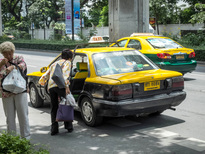
Ticket to ride
ANY person over 22 years of age (not having physical or mental handicap) can apply provided he or she has held a private driving license for at least one year. The applicant has to produce ID, house registration and a medical certificate stating that applicant is in a good health both physically and mentally.
After a test, which takes about five hours, the DLT sends the applicant’s information to the police department to check their background. It takes about 45 days to receive the check. If everything is in order, a taxi driver’s license and yellow taxi card will be issued.
ANY person over 22 years of age (not having physical or mental handicap) can apply provided he or she has held a private driving license for at least one year. The applicant has to produce ID, house registration and a medical certificate stating that applicant is in a good health both physically and mentally.
After a test, which takes about five hours, the DLT sends the applicant’s information to the police department to check their background. It takes about 45 days to receive the check. If everything is in order, a taxi driver’s license and yellow taxi card will be issued.

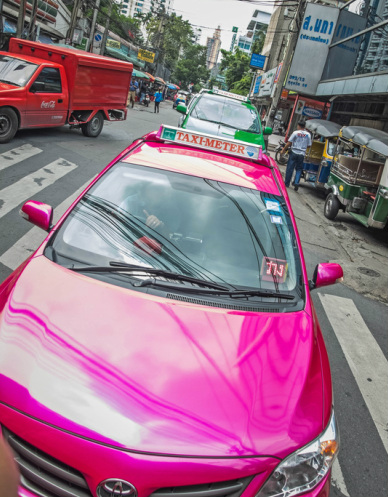
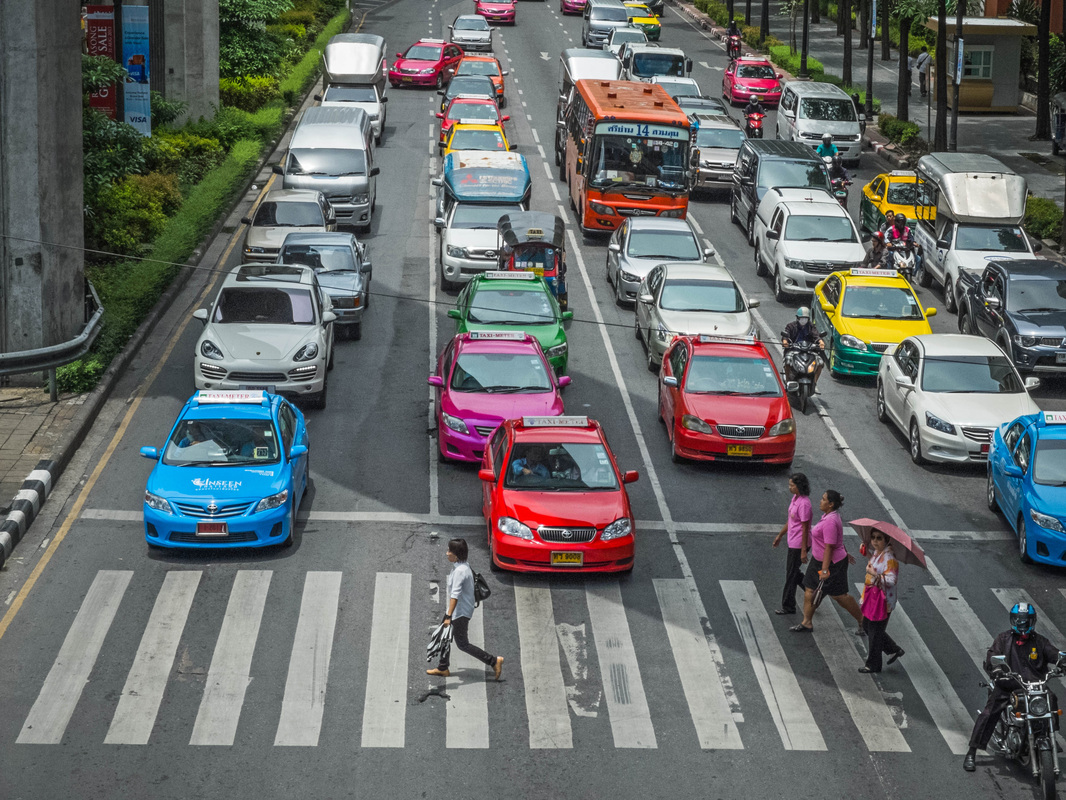
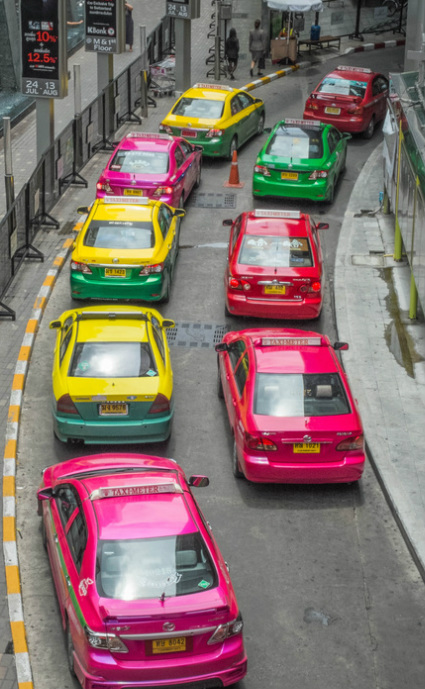
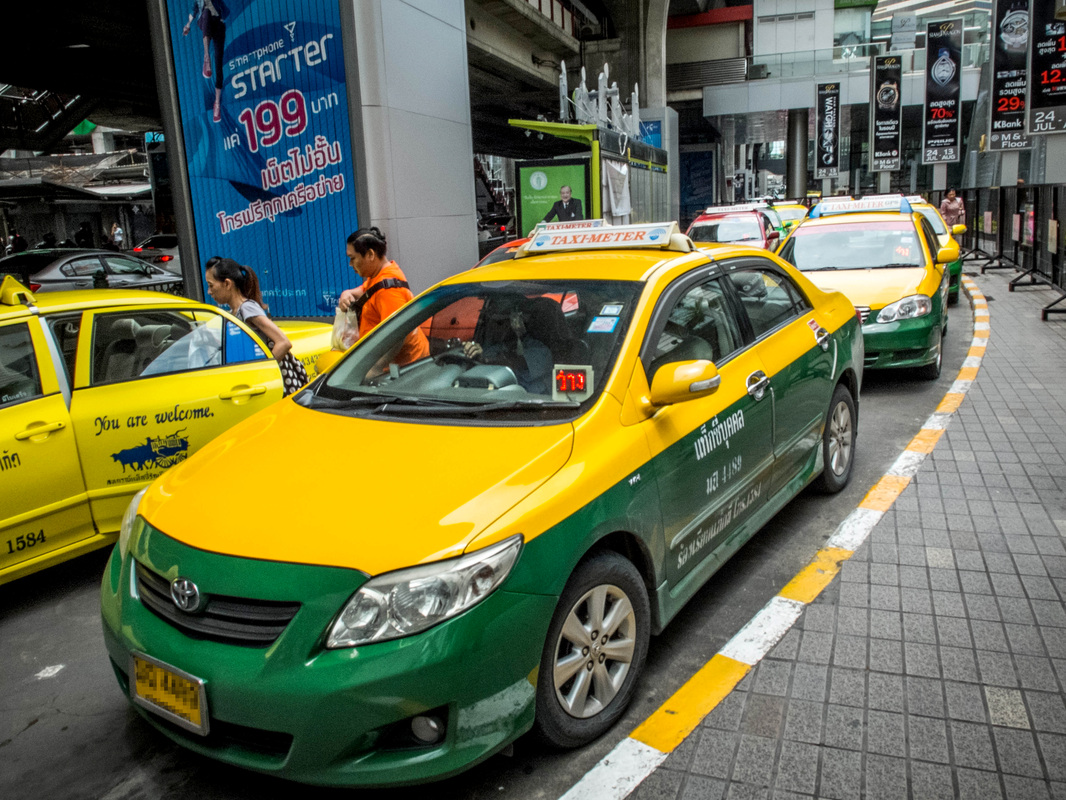
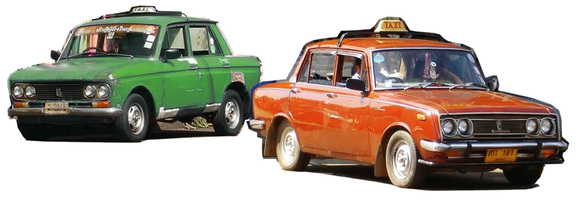
 RSS Feed
RSS Feed





